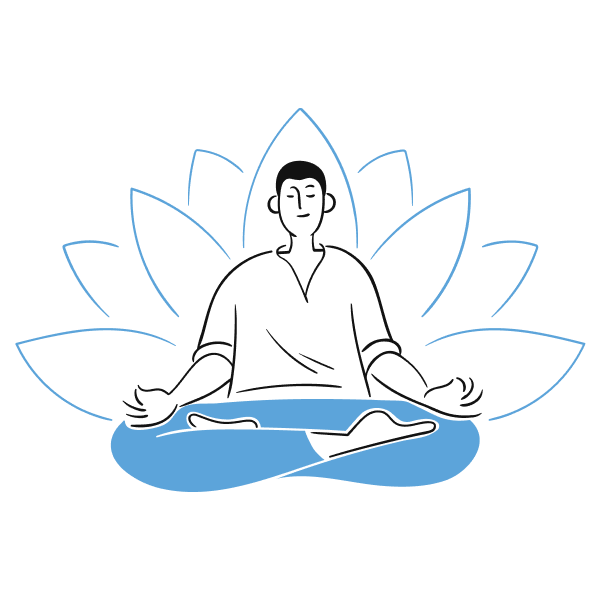Using mindfulness, you learn to be present in the moment. The past is in the past and the future is not there yet. You only have now. Mindfulness exercises help you live mindfully in the moment. In this article, we share exercises you can do yourself.
Why practice mindfulness?
Tips for practicing
There are some common pitfalls that people experience during mindfulness exercises. These tips can help you:
- Choose a time to practice
For example, a specific time during the day or week. Routine helps to make it a habit. - Notice how sounds come and go
You don’t always have to practice in silence. You may have many sounds in your environment, children playing, a ticking clock or a highway with cars passing by. Instead of trying to ignore or be irritated by the sounds, try to notice how the sounds come and go. - Notice when your mind drifts off
When you notice that your mind is drifting off, you are doing the right thing! Be gentle with yourself. The moment you notice that you are wandering, kindly guide your attention back to the exercise. - Keep practicing
Practice makes perfect. Did you not manage to complete an entire exercise the first few times? This doesn’t matter. Try to keep it up a little longer next time.
Exercise #1 – Breathing space
Stay aware in the moment. The Breathing Space exercise allows you to turn off your autopilot and get in touch with the here and now.
- Step 1: Sit quietly
Sit up straight and close your eyes. Notice without judgment what you are feeling, even if it is not a pleasant feeling. You don’t have to do anything. Just experience the feeling. - Step 2: Focus on your breath
Now focus on your breathing. Think of your breathing as an anchor you can always fall back to. A way to bring you back to the present for a moment. Paying attention to your breathing helps you to be attentive and still. - Step 3: Noticing the rhythm
What is the rhythm of your breathing like? Slow, faltering, smooth, deep, shallow? - Step 4: Noticing the location
Where do you feel the air in your body? Do you feel the air going along your nostrils as you breathe in and out? How does your chest move? And your belly? - Step 5: Closure
When you feel that you are calm, with more awareness of the here and now, slowly open your eyes and close the exercise.
Practice with a guided video: https://www.youtube.com/watch?v=8oWmGJc8NWI
Exercise #2 – Five senses exercise
The “Five Senses Exercise” is a nice exercise to clear your head. Do you notice that you are in a situation where you are not mindful and want to shift your attention to the here and now? This exercise will help you do that. Try not to rush when doing the exercise.
- Notice five things you see
Open your eyes and look carefully around you. What do you see? Notice five things you normally see. What does it look like? Does it have a special texture or color? What does the shadow of the object look like? - Notice four things you feel
How does the clothing fit around your body? Or how does the chair you are sitting on feel? Feel four things and notice exactly what you feel. Does it feel rough, soft, warm or cold? - Notice three things you hear
Listen carefully. Do you hear anything? Notice three things in your environment that you hear. A bird whistling or a car driving by. Maybe you hear the washing machine running. It can be anything. As long as you listen consciously for a moment. - Notice two things you smell
Normally, you may not notice smells so quickly. You are usually not actively smelling. Now consciously use your nose and look for two smells in your environment. What does your cup of coffee smell like? Is there still a pleasant smell of laundry on your clothes? Are there flowers on the table? Explore the room looking for two smells. - Notice one thing you taste
Take a bite of food or a sip of drink and describe in your mind what you taste. What flavor does it have?
After these steps, you are fully grounded again. Present and attentive, in the here and now.
Exercise #3 – Observing thoughts
We often feel so connected with our thoughts that we tend to think we are our thoughts. What if we viewed our thoughts more remotely? Simply choose to stop following your thoughts when you notice them.
- Step 1: Sit quietly
Take a few moments to feel your body – focus your attention for a moment on your breathing (as in exercise #1) - Step 2: Focus your attention to your thoughts
Notice the thoughts you are having. How many thoughts pop into your mind in a short period of time? Thoughts are fleeting; they come and go. - Step 3: Observe the flow of thoughts
Now imagine a flowing river. In this river, your thoughts float like bubbles in the flowing river. Do you notice that you linger on a thought for a long time? That you drift along with your thought? Put yourself back on the side of the river and let the thought float away without you. - Step 4: Notice the tone of your thoughts
Now notice the tone of your thoughts. Are they mostly positive or negative? Focused on the future or on the past? Try not to pass judgment on these observations. Only notice. - Step 5: Closure
Let the image of the river fade again and bring your attention to the space where you are now. As you move on with your day, revisit the experience from this exercise. We can look at our thoughts from a distance. Like looking at a river and see how the thoughts come and go.
Practice using this video to become aware of your thoughts.
More information
Are you struggling with mindfulness exercises and do you enjoy finding more peace and relaxation in this way? Mindfulness therapy can help. Mindfulness can provide an anchor in the here and now, taking us out of our worrying about the past or the future.
-
Want to see if Mindfulness is right for you? OpenUp offers very approachable and free mindfulness sessions.
-
Read more about mindfulness therapy.


 Nederlands
Nederlands




